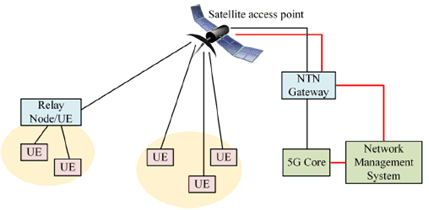Content for TR 22.865 Word version: 19.2.0
5.9 Use case on usage of satellite connectivity for collection of information to aid terrestrial network planning
5.9.1 Description
5.9.2 Pre-conditions
5.9.3 Service Flows
5.9.4 Post-conditions
5.9.5 Existing features partly or fully covering the use case functionality
5.9.6 Potential New Requirements needed to support the use case
...
...
5.9 Use case on usage of satellite connectivity for collection of information to aid terrestrial network planning p. 25
5.9.1 Description p. 25
Network deployment in sparsely populated areas has been a major concern worldwide due to numerous challenges like affordability, infrastructure unavailability, and landscape or topographic conditions. Satellite connectivity can help to serve such areas. However, satellite access may not suffice in all scenarios (for low latency and high throughput applications) and there may be a need for terrestrial network deployment also. In such a situation, satellite connectivity can also facilitate information collection related to UE location and usage statistics, which can later be used for terrestrial network planning in these areas.
Connectivity can be provided in sparsely populated areas through satellite access using direct or indirect access through relay nodes/relay UEs (as shown in Figure 5.9.1-1). This eliminates the requirement of everyone having to use satellite UEs. The service provider can implement a subset of Minimization Drive Test (MDT) procedures to collect information such as location of the UEs through satellite connectivity that can be used by Network Management System (NMS). In addition, usage statistics (for UEs) may also be collected and analysed for the purpose of terrestrial network planning.

Figure 5.9.1-1: Connectivity and data collection from UEs through Satellite Access
(⇒ copy of original 3GPP image)
(⇒ copy of original 3GPP image)
5.9.2 Pre-conditions p. 25
There is satellite access coverage but no terrestrial access network deployed in a sparsely populated area. However, satellite access does not suffice and the service provider needs to augment it with the terrestrial network. Hence, the service provider can conduct some tests to understand the network deployment and planning needs. The service provider's 5G System supports direct connectivity of satellite UEs and indirect connectivity for other UEs via relay nodes/relay UEs.
5.9.3 Service Flows p. 26
A village called Sittlingi has no terrestrial connectivity and residents of this village have to travel a few kilometres to a nearby village office for internet connectivity. Incidentally, this village is covered by satellite access from the service provider TTech Inc. The population in this village is not uniformly distributed and is sparsely populated. TTech is also interested in deploying terrestrial access networks in such areas. TTech wants to survey the area using some reliable mechanism to understand the usage needs of the villagers. Based on this knowledge, the number of base stations, their location and capabilities can be decided for deployment. TTech provides 5GS subscriptions to the users through satellite access. The provider also deploys relay nodes/UEs in the village to provide connectivity to people using non-satellite UEs. The relay nodes use satellite link as backhaul. Residents of the village subscribe and start availing services provided by 5GS. People who use standard off the shelf 5G UEs can be connected to satellite access through relay nodes/ relay UEs. As UEs are connected to the network, 5GS can collect traffic pattern related information from the 5G core user plane function and location related information through conventional Radio Resource Control (RRC) procedures. Based on this information, analysis for the needs and capabilities of terrestrial deployment can be done. Accordingly, terrestrial deployment is planned, designed and further executed. Once TTech completes terrestrial deployment, UEs can get connectivity through a terrestrial base station and satellite access connectivity can be terminated if desired.
5.9.4 Post-conditions p. 26
Service provider TTech is not required to perform some other kind of survey to identify the requirements. The provider utilizes existing 3GPP procedures to get information on usage statistics and location (using 5GS Satellite access) for terrestrial access network planning using optimum resources.
5.9.5 Existing features partly or fully covering the use case functionality p. 26
- Relay UE/ relay node (TR 38.821, TS 22.261) supports terrestrial connectivity to UEs on one end and connects to non-terrestrial access network on the other. The 5G system shall support connectivity using satellite access. (TS 22.261)
- To collect UE specific measurements using control plane architecture, subset of MDT procedures (Reference: TS 37.320) can be triggered.
5.9.6 Potential New Requirements needed to support the use case p. 26
[PR 5.9.6-001]
Subject to regulatory requirements and operator's policies, the 5G system with satellite access shall be able to support collection of information on usage statistics and location of the UEs that are connected to the satellite, for network (e.g. terrestrial) planning.